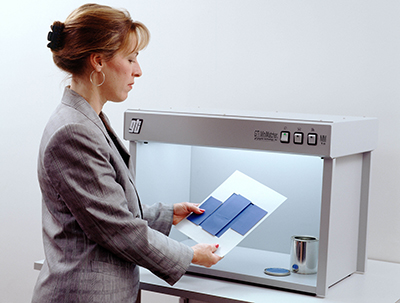Best Practices for Visually Evaluating the Color of Samples
Prior to each visual assessment, the samples being evaluated should be conditioned, if needed, prepared, and presented the same each time. This includes grinding, mixing, or slicing samples the same, placing the samples in the same container, and using the same sample quantity or size for each assessment. During each visual assessment, standardized conditions are required to maintain consistency and accuracy, including lighting, observer, and viewing conditions. Listed below are general best practices for achieving the most accurate results during these visual assessments.
Lighting Conditions
The color of an object may appear differently under one light source than another. This variable often leads to inconsistencies between a sample’s color and the standard color. Because of this, standardized lighting conditions are required to maintain consistency. (Also see “Visual Test for Metamerism” below)
- Evaluate samples within the controlled environment of a light booth to maintain standardized lighting conditions
- Use the same light source(s) in the light booth as the light source(s) where the object will be sold or where it will be used (e.g., use a fluorescent light source if the product is sold in a supermarket or department store)
- Turn off all room lighting except for the light source within the light booth so as not to influence the appearance of the sample’s color, if possible
Observer Conditions
The sensitivity of the human eye varies from person to person, often causing color to appear differently to each individual. In addition, the observer’s attire may affect how they perceive a sample’s color, including their clothing and eye wear. To ensure these visual assessments are as accurate as possible, observer requirements must be defined and followed.
- Organize a committee of people to confirm the results of each assessment and maintain consistency
- Wear neutral colors, such as gray or white, so as not to influence the appearance of the sample’s color
- Do not wear tinted glasses or contact lenses
- Do not assess the samples for more than 5 to 10 seconds before making pass/fail determination because the human eye’s sensitivity to color differences decreases as time goes on
Viewing Conditions
How the sample is viewed can affect the appearance of its color. Viewing an object from a slightly different angle, for example, may make the object appear brighter or darker. Because of this, the angle at which the sample is viewed and other viewing conditions must be consistent for each assessment.
- Do not place any other objects in the light booth other than the samples being assessed so as not to affect the appearance of their color
- Lay the samples flat in the light booth or position them at a 45-degree angle. Reverse their position left to right and top to bottom to observe any changes in color
- When comparing the sample against the standard, hold or lay them side by side so that they are parallel to each other and touching to more easily identify color differences
Visual Test for Metamerism
Metamerism describes a pair of objects that match in color under one light source or set of viewing conditions but not under another. This often occurs when the color batch or recipe for dyes, paints, inks, or other pigments is changed during production, leading to mismatched colors. A shirt, for example, might appear to match the color of a cardigan when viewed in daylight, but they do not appear to match when viewed under incandescent lighting at home.
To determine if a pair of samples are metameric, visual and instrumental tests are required to evaluate the samples under two or more different light sources and illuminants, such as daylight (Standard Illuminant D65) and incandescent light (Standard Illuminant A). Listed below are the steps to identifying metamerism through a visual test.
1. Place the two samples being questioned in the light booth under one light source and visually compare them
2. Change the light source (e.g, from Standard Illuminant D65 to Standard Illuminant A) and visually compare the samples again to see if they match in color
3. If the samples match under one light source but not under another, then they are considered a metameric pair. For the most accurate results in a visual test, the samples should be compared under at least three different light sources
To confirm the samples are metameric, an instrumental test must be performed using a spectrophotometer. In cases where samples are not an exact color match to the standard under all lighting conditions, it is important metamerism is identified and kept to a minimum. With the proper tools and color processes set in place, a “good” metameric match can be produced.
Performing visual assessments of samples early in the process helps identify inconsistencies to avoid rework later on. As a result, operational efficiency improves, and rejects are reduced.
Like this article? Click here to sign up for our monthly Color Trends & Technology newsletter to stay updated on the element of color, best practices for controlling and evaluating the color of objects, educational seminars, and advanced technology for research and manufacturing environments.
The technological leader in color and light measurement solutions, Konica Minolta Sensing Americas helps organizations formulate, evaluate, and control color to meet product quality and operational goals more efficiently.











